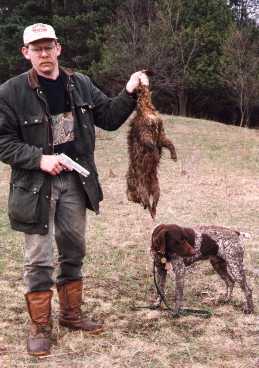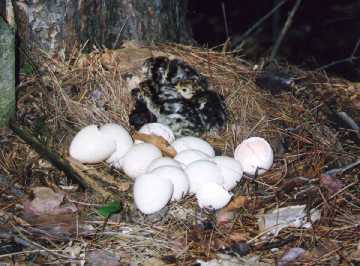
This article was published in Issue # 26, April 1998, of The Varmint Hunter, the magazine of the Varmint Hunting Association, I greatly appreciate their interest and generosity in publishing this rather weak attempt at outdoor writing.....

Manfred had been barking for more than 10 minutes by the time I determined his location, but now, between barks, his adversary was heard. It was snarling, bawling and growling, and it sounded as though he had cornered a bear cub. Deep in the cedar swamp on our northern Michigan property my 70 lb. German Shorthaired Pointer was trying to add yet another species to his trophy den. This one did not sound like it would be easy.
Most people who hunt varmints do so with either a long range sniper-type setup, or call in the quarry to shotgun range. My Savage 112V in .22-250 has scored on a 450-yard crow, and my short barreled 1300 Winchester is a great varmint-oriented lead distribution device. I enjoy hunting varmints with both techniques, but I think its more fun at spitting distance with a .45 government model and an irate hunting dog than with the aforementioned more traditional methods. We donít go out looking to hunt varmints this way, but the dog usually finds some during the course of building tree stands, clearing brush, or other boring maintenance activities.
I slogged on, and at last, the dog was finally visible. He was up to his chest in water, holding an old boar raccoon at bay under a blow down. It had taken another five minutes to get to the point where this altercation could be seen. We were in a section of the swamp that is never explored, except in the dead of winter when ice at least makes the water traversal. Numerous dead falls, new growth, and tangle-foot roots make traveling even 20 yards a sweat soaked affair. Knee deep in black swamp water, I was only 5 yards from the melee.
The raccoon had no way of escape. He was backed against the remnants of this long dead tree, fangs bared, ears laid back. The dog had the same expression, except he had the upper hand and seemed to be enjoying himself. Manfred would lunge in and pin the raccoon, going for the throat, but the raccoon was too tough, too experienced to let the dog administer last rights. Just as the dog would seem to get the advantage, Mr. Bandit would bite at the face or dig at the eyes of the dog, causing him to let go and jump back to consider his next move. Old Slab-Sides, a customized 1911 model .45, was ready. At a break in the action, I fired a double-tap at his mask. A 200 grain LSWC (Lead Semi-WadCutter) at 900 fps knocked him back against the tree, but he recovered impossibly from that hit, snarling at me this time, glaring with the one eye he had left. As the bandit now moved toward me, the dog jumped in again, only to be repelled by the fierce defense of this tough varmint.
 |
Another break, another double-tap. This time both hit home, one high in the chest, the other in the shoulder. As the raccoon fell off the stump and sank into the water, he amazingly attempted to swim away from us. One round between the shoulders put him down for good, and Manfred got in a few last chomps for good measure. Or maybe just revenge. I hauled the dead bad guy out of the swamp and as is our custom, let Manfred bury him after we had gotten pictures for his album. Itís hard to get use out of a pelt so mangled by fang and bullet. |
I know more than a few "Pointing Dog Purists" who get indignant when the success this dog has with varmints is mentioned. "Why, youíll ruin him for birds!" or "Pointers ainít meant to hunt fur" are some of the comments derisively tossed our way. They put forth these jewels of canine claptrap without knowing that the early development of this breed was influenced by the German customs and game laws of that time. Most hunters couldnít afford to have bird dogs, rabbit dogs, pest control dogs, companions and duck dogs. They bred the Shorthair, the Weimeraner, the German Wirehair, and others, to be versatile hunters, capable of accomplishing a variety of tasks in a workmanlike, if not flashy, manner. These dogs were also required to be sharp, or capable of going up against any beast not worthy of the table or likely to inflict damage to the local game populations. In other words, they were also breeding varmint hunters.
Manfred is the best pheasant and chukar dog I have ever worked with, so it seems a little fur hasnít spoiled his appetite for feathers. Even with the supposed negative impact his varminting has on his bird hunting, his points on birds are always rock hard and stylish, head and tail high. He has in his game portfolio several dozen pheasant, chukar and quail. In his five year career he has also scored on woodcock and grouse, trees squirrels like a terrier and for good measure points rabbits for me after bird season has ended. On his varmint scoresheet are crows, moles, opossum, skunk (the memories of those kills always seem to linger longer than the others), porcupines, woodchuck, rats, feral cats, raccoons, and the occasional mouse. He always seems to know if the critter scented is game or varmint, pointing the game but giving voice and chase to the bad guys. Many of his varmint assassinations have been solo endeavors, but he always fetches his kill home, to show his work and receive high praise for a job well done.
Quite a few of the occasions Iíve had to kill varmints over the dog have come as ancillary exercises during bird hunts. Once, while on federal land on the opening weekend of the small game season, I whistled for Manfred to hunt a little closer to the hunting party. We heard his bell signal his return, but at about 30 yards out, the bell stopped ringing. Assuming the dog was on point, I made my way through the thick underbrush and popple to reach his position. After a brief search I was able to locate the dog. He was on a steady point, indicating game under a stump about 10 yards from his nose. Hoping a rabbit might be headed for the game bag, I kicked the stump. Nothing. I kicked again, only to have the fanning back spread of a huge porcupine rise from the other side of the stump. Knowing that the dog would attempt to retrieve shot game, I maneuvered around to the dog, grabbed him by the collar with my left hand, and edged closer to the stump. The first round from my little 20 gauge knocked the pin pig out of his impromptu shelter, the next round knocked him out for good. If you have ever seen the damage porcupines can do to good dogs and valuable timber, you know the satisfaction I felt by artificially air conditioning his liver. Manfred routinely barks over porky until I arrive, he then points to indicate the bad guy. Five too close encounters with porcupines may have at last educated this birddog.
The .45 ACP is in every aspect a classic cartridge. Its mil-spec configuration calls for a 230 grain round nose full metal jacket at about 850 fps, the so-called hardball load. Since most of my shooting is done with handloads, and I have no use for mil-spec ammo, I prefer a 200 grain bullet. The 200 grain lead semi-wadcutter can be loaded slow for light target shooting and plinking, or a jacketed hollow point can be run up to 1050+fps for a hunting or self-defense load. My favorite varmint load for the .45 is a 200 grain LSWC over 5.5 grains of HP-38. Velocities get to about 900 fps. Case and primer selection is not too critical for accuracy; at these distances you could throw a rock or swing a stick if you run out of ammo.
A semi-wadcutter profile cuts a clean .45 caliber hole, a definite performance advantage over the round nose design of the hardball bullet which punches through tissue rather than cutting it. Unlike a 3700 fps .22-250, a handgun round rarely generates enough velocity to create any red-mist inducing hydrostatic shock. As the incident with the raccoon illustrates, bullet placement is everything when using a handgun.
The weapon that sees the most duty during these operations is an Auto-Ordnance 1911. When new it was a parkerized, mil-spec weapon, but has since undergone serious customization. Aftermarket safeties, trigger, barrel, and sights help it shoot tighter, an industrial hard-chrome finish keeps it rust free. The slide, barrel, and frame have been carefully hand fitted, as have the aftermarket goodies. While some government model .45s get finicky after accurization, this one feeds and functions flawlessly. With a target load of 5 grains of HP-38 driving a 200 grain Speer copper jacketed semi-wadcutter the weapon will group inside 2 inches at 50 feet. I carry the .45 at all times on the property due to the numerous varmint eradication opportunities. A full mag in the weapon, plus one magazine each of the LSWC and the hollowpoints in a GI mag pouch on my belt, and weíre ready for action.
The Weaver Compound for the Politically Incorrect, as friends call it, is in northern lower Michigan, in lightly populated farm and backcountry. A wide variety of habitats provide homes to many types of fauna. Big whitetail are numerous, as are rabbits, squirrel, grouse, turkey, and waterfowl. Varmints include woodchuck, opossum, skunks, coyote, fox, crow, red squirrel and of course, raccoon and porcupine. I feel obligated to remove as many porkys as possible for obvious reasons, but the possum, skunks, raccoon, feral cats and crows do such damage to turkey, grouse, waterfowl and songbird nests they get the good word too. If they are around, Manfred will let me know.
Then there are the bear. Our area has just been declared a bear management unit, which means we have a huntable population of the bruins. Occasionally we run across sign, or hear from a neighbor that (picture Walter Brennan), "Ya know, we just seen a couple of bruins come outa yer swamp last week, hee, hee". The 9mm I used to carry seemed to get real small really quick. A 5Ĺ" Ruger Redhawk in .44 magnum gets toted on occasion but itís a bit too cumbersome for everyday carry. While the bear in the area are small as bear go, the .45ACP is admittedly only marginal for the beasts, and should only be utilized as a last resort. They are best avoided if at all possible. Hopefully the dog understands this.
The property is managed for deer hunting, but we do appreciate the numerous turkey and other wildlife living there. While hunting for morels last spring we happened upon a turkey nest with a dozen eggs in it. That day the birddog located a porcupine and an opossum very near to the turkey nest. They were not given an opportunity to plead their case, as the porky took one from the .45 and Manfred did quite a bit of damage to the possum before John Browningís creation finished the job. Those turkeys hatched the next day, but had the possum lived to hunt through the night all bets are off on their survival. I can count on the dog to rustle up critters whenever we visit the place. With a cartridge as versatile as the .45ACP, and a birddog with a negative attitude toward varmints, we are sure to be ready for any bad guy that comes looking for an easy meal.

Thank you Uncle Manfred!
 Varmint Hunters Association: Courtesty, Camaraderie, Conservation
Varmint Hunters Association: Courtesty, Camaraderie, Conservation


ALL RIGHTS RESERVED